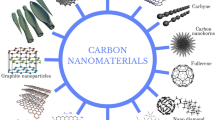Abstract
A novel hybrid material based on multi-walled carbon nanotubes was synthesized using organic synthesis, and the structures of multi-walled carbon nanotube derivatives were characterized by Fourier transform infrared spectroscopy, X-ray diffraction, thermogravimetric analysis, 1H NMR spectroscopy, transmission electron microscopy, and scanning electron microscope. The analytical results indicated that β-cyclodextrin (β-CD) was anchored to the surface of Multi-walled carbon nanotubes (MWCNTs, OD: 10–20 nm, length: 10–30 μm) and dispersion experiments exhibited that the introduction of β-CD onto the MWCNTs would dramatically enhance the dispersion of MWCNTs in both ethanol and water media; the suspensions were found to be very stable for 2 months, and the results of this technique confirmed the experimental results. This novel technique would provide a new, simple, and facile route to prepare the modified nanomaterials based on silane-coupling agent and β-CD, and the obtained modified nanomaterials have great potential practical significance and theoretical value to develop the novel organic–inorganic hybrid material, which was very useful for water treatment and biological medicine.










Similar content being viewed by others
References
Bratu I, Astilean S, Ionesc C (1998) FT-IR and X-ray spectroscopic investigations of Na-diclofenac-cyclodextrins interactions. Spectrochimica Acta A Mol Biomol Spectroscopy 54(1):191–196
Cao L, Yang W, Yang J, Wang C, Fu S (2004) Hyperbranched Poly(amidoamine)-modified Multi-walled Carbon Nanotubes via Grafting-from Method. Chem Lett 33(5):490–491
Chen Y, Li F, Liu BW (2010) Thermodynamic origin of selective binding of β-cyclodextrin derivatives with chiral chromophoric substituents toward steroids. J Phys Chem B 114(49):16147–16155
Dai LM, He PG, Li SN (2003) Functionalized surfaces based on polymers and carbon nanotubes for some biomedical and optoelectronic applications. Nanotechnology 14:1081–1097
Engeldinger E, Armspach D, Matt D (2003) Capped cyclodextrins. Chem Rev 103(11):4147–4174
Gao M, Dai LM, Wallace GG (2003) Biosensors based on aligned carbon nanotubes coated with inherently conducting polymers. Electroanalysis 15:1089–1094
Giordano F, Novak C, Moyano JR (2001) Thermal analysis of cyclodextrins and their inclusion compounds. Thermochim Acta 380:123–151
Ha JU, Kim M, Lee J, Choe S, Cheong W, Shim SE (2006) A novel synthesis of polymer brush on multiwall carbon nanotubes bearing terminal monomeric unit. J Polym Sci A Polym Chem 24:6394–6401
He Z (2008) Cyclodextrin inclusion technology. People’s Publishing House, Beijing
He Y, Xu ZH, Wu F, Luo Z, Chen CL (2014) Synthesis and characterization of a novel amphiphilic copolymer containing β-cyclodextrin. Colloid Polym Sci 292:1725–1733
Iijima S (1991) Helical microtubules of graphitic carbon. Nature 354:56
Khaled E, Kamel MS, Hassan HNA (2012) Novel multiwalled carbon nanotubes/β-cyclodextrin based carbon paste electrode for flow injection potentiometric determination of piroxicam. Talanta 97:96–102
Kim M, Hong CK, Choe S, Shim SE (2007) Synthesis of polystyrene brush on multiwalled carbon nanotubes treated with KMnO4 in the presence of a phase-transfer catalyst. J Polym Sci A Polym Chem 45:4413–4420
Kolokolov DI, Herve JD, Alexander G (2010) Dynamics of benzene rings in MIL-53(Cr) and MIL-47(V) frameworks studied by 2H NMR spectroscopy. Angew Chem 49(28):4791–4794
Mattson MP, Haddon RC, Rao AM (2000) Molecular functionalization of carbon nanotubes and use as substrates for neuronal growth. J Mol Neurosci 14:175–182
Morin N, Chilouet A, Milet J (2000) Bifonazole-β-cyclodextrin inclusion complexes thermal analysis and X-ray powder diffraction study. J Thermal Analysis Calorimetry 62:187–201
Murugan E, Vimala G (2011) Effective functionalization of multiwalled carbon nanotube with amphiphilic poly(propyleneimine) dendrimer carrying silver nanoparticles for better dispersibility and antimicrobial activity. J Colloid Interface Sci 357:354–365
Park HJ, Kim J, Chang JY, Thetao P (2008) Preparation of transparent conductive multilayered films using active pentafluorophenyl ester modified multiwalled carbon nanotubes. Langmuir 24:10467–10473
Rekharsky MV, Inoue Y (1998) Complexation thermodynamics of cyclodextrins. Chem Rev 98(5):1875
Shen Z, Ma J, Liu Y (2005) β-cyclodextrin-immobilized (4S)-phenoxy-(S)-proline as a catalyst for direct asymmetric aldol reactions. Chirality 17(9):556–558
Sinani VA, Gheith MK, Alexander A, Yaroslavov A, Anna RK (2005) Aqueous dispersions of single-wall and multiwall carbon nanotubes with designed amphiphilic polycations. J Am Chem Soc 127:3463–3472
Szejtli J (1982) Cyclodextrins and their inclusion complexes. Akademiai Kiado, Budapest
Wang Z, Wang Y, Luo G (2002) A selective voltammetric method for uric acid detection at β-cyclodextrin modified electrode incorporating carbon nanotubes. Analyst 127:1353
Wang Z, Liu Q, Zhu H, Liu H, Chen Y, Yang M (2007) Dispersing multi-walled carbon nanotubes with water-soluble block copolymers and their use as supports for metal nanoparticles. Carbon 45:285–292
Xu G, Wu WT, Wang Y, Pang W, Wang P, Zhu Q (2006) Synthesis and characterization of water-soluble multiwalled carbon nanotubes grafted by a thermoresponsive polymer. Nanotechnology 17:2458–2465
Acknowledgments
The authors gratefully acknowledge the financial support from Sichuan Province Basic Research Plan Project 2013JY0099, Sichuan Science and Technology Innovation Seedling Project Funded Projects 2014-073, and the foundation of State Key Lab of Oil and Gas Reservoir Geology and Exploitation PLN0806.
Author information
Authors and Affiliations
Corresponding author
Rights and permissions
About this article
Cite this article
He, Y., Xu, Z., Yang, Q. et al. Supramolecular modification of multi-walled carbon nanotubes with β-cyclodextrin for better dispersibility. J Nanopart Res 17, 48 (2015). https://doi.org/10.1007/s11051-015-2866-z
Received:
Accepted:
Published:
DOI: https://doi.org/10.1007/s11051-015-2866-z




